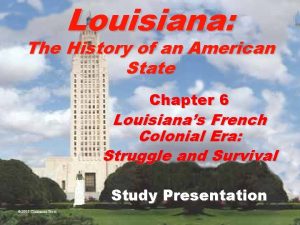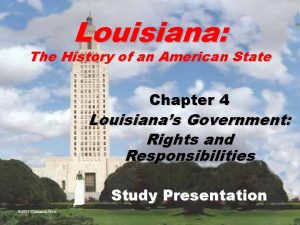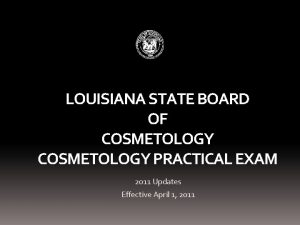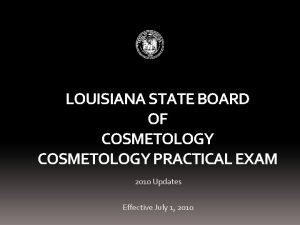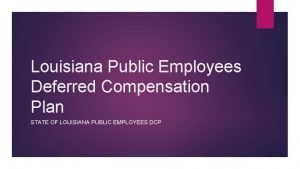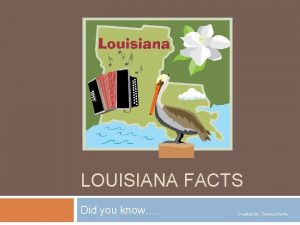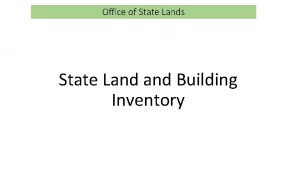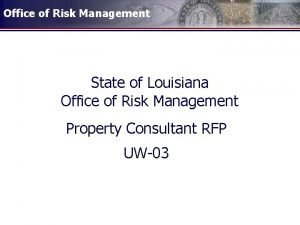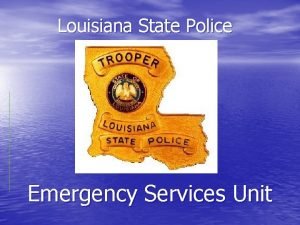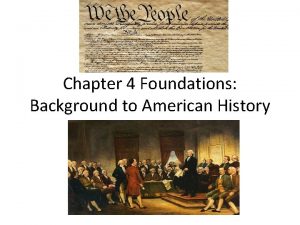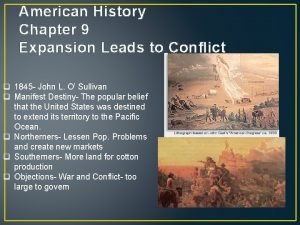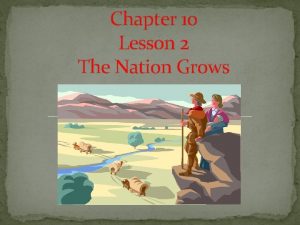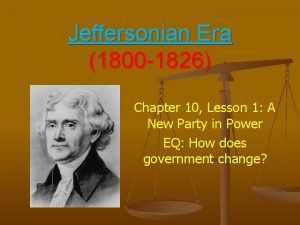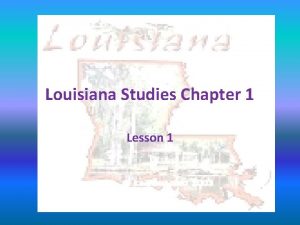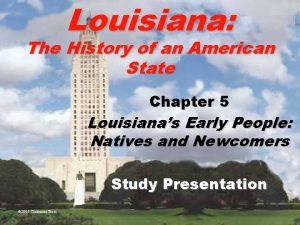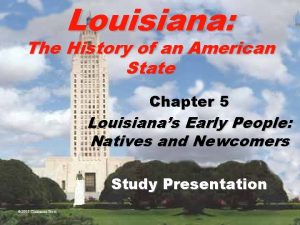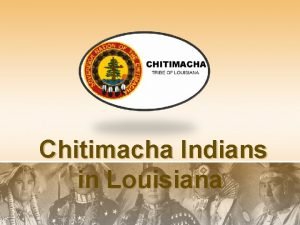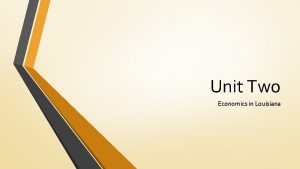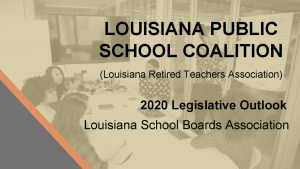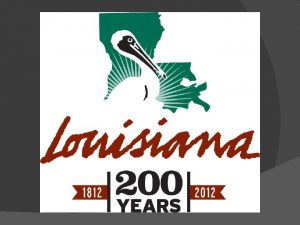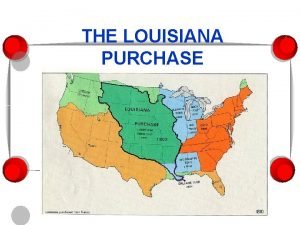Louisiana The History of an American State Chapter









































- Slides: 41

Louisiana: The History of an American State Chapter 6 Louisiana’s French Colonial Era: Struggle and Survival Study Presentation © 2005 Clairmont Press

Chapter 6: Louisiana’s French Colonial Era: Struggle and Survival Section 1: The French Come to Louisiana Section 2: Louisiana as a Proprietorship Section 3: A Royal Colony Again

Section 1: The French Come to Louisiana ESSENTIAL QUESTION: – What were the effects of the French exploration of Louisiana?

Section 1: The French Come to Louisiana What word do I need to know? 1. colony

Section 1: The French Come to Louisiana • France wanted to expand trading area in New World • 1673: exploration of Mississippi River (to discover Northwest Passage) by Louis Joliet & Father Marquette • Return trip north due to risk of encounter with Indians / Spanish soldiers

Timeline: 1673 A. D. – 1712 A. D. • 1673: Joliet & Marquette explored the upper Mississippi • 1682: La Salle claimed Louisiana for France • 1699: Iberville est. Fort Maurepas • 1712: Crozat became proprietor

Timeline: 1714 A. D. – 1736 A. D. • 1714: Natchitoches founded • 1717: Company of the West became Louisiana proprietor • 1718: New Orleans founded • 1729: Natchez uprising • 1736: Chickasaw War

Exploring the Mississippi • 1682: exploration of La Salle, to find water route to China & spread religion of France – All land drained by Mississippi River claimed by La Salle for Louis XIV – Land named Louisiana (“Land of Louis”) • Return of La Salle to France to report discovery • Continuation of La Salle’s mission (a failure) – Off-course route of fleets – Frustration / deaths of many colonists – La Salle’s men mutinied & he was murder by his men

The French Colony • Set in motion by La Salle • French fort needed to guard Mississippi River (recognized by Louis XIV) • Spanish fort built on the Gulf of Mexico at Pensacola Bay • British hoped to build at the mouth of the Mississippi River • French interests represented by French Commander Pierre Le Moyne and his younger brother, Jean Baptiste Le Moyne

Fort Maurepas • Fort at Pensacola: held by Spanish – the best harbor near the Mississippi River • Ship Island claimed by Iberville • Primitive huts built as a temporary camp • Letter to La Salle found in 1685 – proof 13 years later of French discovery of Mississippi River • Gulf Coast: a better location for Iberville’s fort (near present-day Biloxi) • Trees plentiful to build the fort

A Struggling Colony • Challenges facing French colonists: – the British – the local Indian tribes • Bienville successfully bluffed a British captain into leaving the Mississippi River • English Turn, along the Mississippi River, still on today’s map • Blended with the Indians at first, but conflicts later initiated to keep them from unifying against the French

Other Forts • Fort Mississippi built 54 miles above the mouth of the river • Fort Maurepas, French headquarters, moved due to flooding • New fort, Fort Louis: built to keep the English out of Mobile Bay – later became the city of Mobile – Commanded by Henri de Tonti until his death from yellow fever in 1704

Leadership • Happenings as Iberville returns to France – War in Europe – Iberville required to return to military duty – Iberville’s requests for colonists / supplies ignored • Hard times in France created by war – Supply ships involved in war effort – Louisiana colony left defenseless / inadequate supplies

Leadership • 1702: Death of Iberville (in Havana) • Challenges facing Bienville – New leader of colony (1701) – Faced criticism / complaints from officials & priests • Conflicts regarding confusing structure of government Click here to return to Main Menu.

Section 2: Louisiana as a Proprietorship ESSENTIAL QUESTION: – What were the effects of the Company of the West and the collapse of the Mississippi Bubble?

Section 2: Louisiana as a Proprietorship What words do I need to know? 1. proprietorship 2. Superior Council 3. land grant 4. Mississippi Bubble 5. slave 6. plantation 7. Code Noir

Louisiana as a Proprietorship • Introduction - Ending of costly war in Europe - Push by British colonies to expand trade with Native Americans - Colony needed as buffer against British • Proprietorship established by King Louis XIV • Charter (contract) given to one individual (proprietor) - Total control by proprietor - Certain requirements of proprietor • Operate colony as a business • Send on regular basis supplies/settlers • Maintain French laws of government

Antoine Crozat • 1712: Proprietorship of Louisiana given to Antoine Crozat by French royal government – Money loaned to King Louis XIV by Crozat – Expectations by Crozat to find gold/silver in colony – Little interest in settlers/agriculture – Primary motive as proprietor profit – Selection of new governor (Antoine de Lamothe, Sieur de Cadillac)

Antoine Crozat • Difficulties faced by Cadillac (as leader) – Refused to smoke Indian calumet – Exhibition of rude personality – Ongoing conflicts among government officials • Cadillac’s credits for organizing colony – Establishment of Superior Council to help govern colony – 1 st official suggesting indigo & tobacco be grown to sell – Efforts to convince Crozat to send more people to Louisiana

Natchitoches • Louis Juchereau de St. Denis selected by Cadillac to command fort at Natchitoches – Possessed knowledge of Indian languages and frontier skills – Educated in Paris • 1714: Fort St. Jean Baptiste (present-day Natchitoches) built by French on banks of Red River – Established to build trade with nearby Spanish (illegal)

Natchitoches • Missions by St. Denis to seek trade – Eventually St. Denis jailed – Warned to stay out of Spanish territory • Continued trade efforts between Spanish colonists – French goods desired by Spanish (especially medicine) – Spanish silver desired by French

Crozat’s Failure • Continued struggle of Louisiana colony – Ending of government support (death of Louis XIV, 1715) – Trading with Spanish (illegal) and Indians - a failure – French disinterest in farming • No profit made from colony • Contract as proprietor not totally fulfilled • Gave up proprietorship (after 5 years)

The Company of the West • Next proprietor of colony (group of investors) • John Law (head of proprietorship group) – Developed paper money system for France • 1717: Company of the West created by John Law to operate Louisiana colony • 1718: Settlement designed / laid out by Bienville (became city of New Orleans) • Land grant given to directors in exchange for settlers to live on the land

A Search for Colonists • • Early real estate advertising used by John Law in efforts to attract people to Louisiana German farm families recruited as colonists – Experienced, hard-working people – Cleared land, planted gardens – Saved colony from starving Need still for more settlers – Prisoners sent to colony rather than jail – Arrival of dangerous criminals (unable or unwilling to work) Problems in the colony – Vagrants (homeless people) shipped to colony – Goods not often sent to colony by the Company – Available goods more costly

The Collapse of the Mississippi Bubble • Continued investments / expansion of the Company • 1721: Collapse of the Company (called Mississippi Bubble) • The Company of the Indies (in charge of colony) • Continuation of Bienville as governor • Needs of Louisiana – an adequate army – more dependable settlers – a good export crop

The Code Noir • 1716: Beginning of slavery in Louisiana (to provide workers for colony) – slaves from West Africa – rice added as staple food for colony (assistance from slaves) • Indigo & tobacco (Louisiana’s 1 st cash crops) • 1724: Code Noir established by Bienville – governed conduct / treatment of slaves – protected slaves as property

A New Governor • Complaints about Bienville as governor • Etienne de Perier – new governor – Mission: to bring harmony to colony – Well-respected in French navy – Saw potential in Louisiana’s forests – Desired to improve trade with French colonies of West Indies

The Natchez Uprising • Peaceful relations between colonists and Indians at Fort Rosalie (built 1716: Fort Rosalie built on land belonging to Natchez Indians) • Good land seized from Natchez Indians by fort’s commander • Natchez Indian attack of Fort Rosalie (called “Natchez Uprising” – deaths of 250+ colonists) • Loss of farms / tobacco plantations / desire to stay in colony • 1731: Colony returned to King by Company of the West Click here to return to Main Menu.

Section 3: A Royal Colony Again ESSENTIAL QUESTION: – What problems were faced by the various groups that attempted to colonize French Louisiana?

Section 3: A Royal Colony Again What word do I need to know? 1. casket girls

Bienville Returns • Challenges facing Bienville upon return as governor: – Calm the settlers / restore ties with Indians – Shortage of livestock & good tools – Inadequate supply of money – Few ships available to transport goods • Food rationing in colony & reliance on barter and warehouse credit

War with the Chickasaw • Conflicts between tribes used often to advantage of French and British – French goods generally preferred by Choctaw – British (trading partners & allies with Chickasaw) – Chickasaw (enemies of French & Choctaw) • French fearful of peaceful relations between Chickasaw and Choctaw • France’s colony threatened by possible trading partnership between Choctaw and British • Eventual war lasting for several years between Chickasaw and French – Several defeats suffered by Bienville – 1742: Retirement of Bienville as governor of colony

A Different Kind of Governor • 1742: New governor (Pierre Francois de Rigaud, Marquis de Vaudreuil) – Halted Indian raids on settlements – Worked out peace agreement with Chickasaw – Used kindness and dignity to calm internal conflicts in colony • Improved living conditions & prosperity for colony • Formal ceremonies & parties established • Governor credited with 1 st Louisiana Mardi Gras ball

The Last French Years • 1752: Vaudreuil designated as governor of Canada • Louis Billouart, Chevalier de Kerlerec appointed governor of colony – Tensions between French and British increasing – Stage set for French and Indian war – Caught in middle of squabbles with commissary commissioner • 1762: Colony given to Spain

Life in the Colony • • • Began as a struggle in French colonial Louisiana in the wilderness Challenging environment Adaptation of people to suit location Daily hardships faced by colonists Elements of culture added to improve their lives

The People • Early explorers and promoters (hardy French Canadians) – Free-spirited woodsmen (coureur-de-bois – “woods runner” in French – Preferred independent lifestyle to settling in colony • Early French colonists – Lacked survival skills for harsh environment – Many interested in search for gold & silver • German farmers (hardy, saved colony)

The People • African slaves (hard labor, created economic growth in colony) • Soldiers (considered as rejects of army) • Women – Scarce in the colony – Absence, causing instability in colony – 1728: Arrival of “casket girls” – Some women of bad reputation sent from the streets of Paris

Religion • Roman Catholic: official religion of France and the Louisiana colony • Church supported by the government • Nuns & priests provided for the colony • Few of the early priests lived among the Indians as missionaries • Schools established by nuns & priests • Early days: Mardi Gras & other church holidays celebrated

Lifestyles • Early population of Louisiana between 6, 000 & 7, 000 when colony given up by France • Gambling & card playing main entertainment • Few elegant homes, majority of logs or bricks • Ignorant about diseases / health awareness • Jean Louis: money left in will (provisions for a charity hospital in New Orleans) • Clothing: made mostly from imported cloth – elegant clothing (from France) worn by wealthy

Success or Failure • Factors contributing to success or failure of French colony of Louisiana – Colony under regulations of France – Colony affected by hurricanes, mosquitoes, heat, & humidity – The first colonists – a poor choice? – Leaders of the colony • Those seeking to benefit colony • Those seeking profits for themselves – Trade restrictions – Inadequate funding & supplies Click here to return to Main Menu.

Click here to return to Main Menu.
 Louisiana the history of an american state
Louisiana the history of an american state Louisiana the history of an american state
Louisiana the history of an american state Louisiana cultural regions map
Louisiana cultural regions map State board pin curls
State board pin curls How to schedule cosmetology practical exam
How to schedule cosmetology practical exam State of louisiana deferred compensation plan
State of louisiana deferred compensation plan Louisiana state tree
Louisiana state tree E verify enrollment checklist
E verify enrollment checklist Claudia cavallino
Claudia cavallino Louisiana office of state lands
Louisiana office of state lands Louisiana risk management
Louisiana risk management La tech biomedical engineering curriculum
La tech biomedical engineering curriculum Louisiana state police tier ii reporting
Louisiana state police tier ii reporting Doa louisiana
Doa louisiana Chapter 4 foundations background to american history
Chapter 4 foundations background to american history Chapter 10 section 2 the history of american banking
Chapter 10 section 2 the history of american banking American history chapter 9
American history chapter 9 Chapter 10 lesson 2 the louisiana purchase
Chapter 10 lesson 2 the louisiana purchase Chapter 10 lesson 2 the louisiana purchase
Chapter 10 lesson 2 the louisiana purchase Hát kết hợp bộ gõ cơ thể
Hát kết hợp bộ gõ cơ thể Lp html
Lp html Bổ thể
Bổ thể Tỉ lệ cơ thể trẻ em
Tỉ lệ cơ thể trẻ em Voi kéo gỗ như thế nào
Voi kéo gỗ như thế nào Chụp tư thế worms-breton
Chụp tư thế worms-breton Bài hát chúa yêu trần thế alleluia
Bài hát chúa yêu trần thế alleluia Các môn thể thao bắt đầu bằng tiếng chạy
Các môn thể thao bắt đầu bằng tiếng chạy Thế nào là hệ số cao nhất
Thế nào là hệ số cao nhất Các châu lục và đại dương trên thế giới
Các châu lục và đại dương trên thế giới Công thức tính thế năng
Công thức tính thế năng Trời xanh đây là của chúng ta thể thơ
Trời xanh đây là của chúng ta thể thơ Mật thư tọa độ 5x5
Mật thư tọa độ 5x5 Phép trừ bù
Phép trừ bù độ dài liên kết
độ dài liên kết Các châu lục và đại dương trên thế giới
Các châu lục và đại dương trên thế giới Thể thơ truyền thống
Thể thơ truyền thống Quá trình desamine hóa có thể tạo ra
Quá trình desamine hóa có thể tạo ra Một số thể thơ truyền thống
Một số thể thơ truyền thống Cái miệng nó xinh thế
Cái miệng nó xinh thế Vẽ hình chiếu vuông góc của vật thể sau
Vẽ hình chiếu vuông góc của vật thể sau Thế nào là sự mỏi cơ
Thế nào là sự mỏi cơ đặc điểm cơ thể của người tối cổ
đặc điểm cơ thể của người tối cổ
